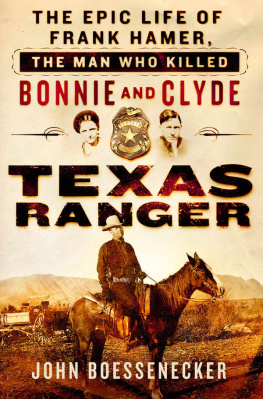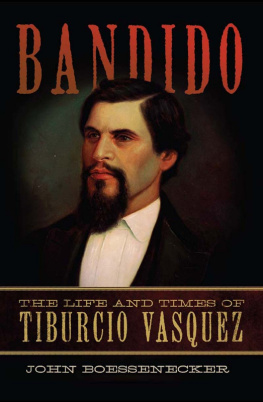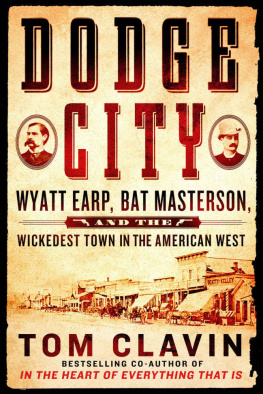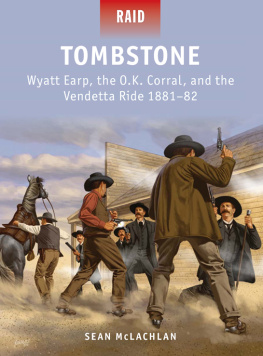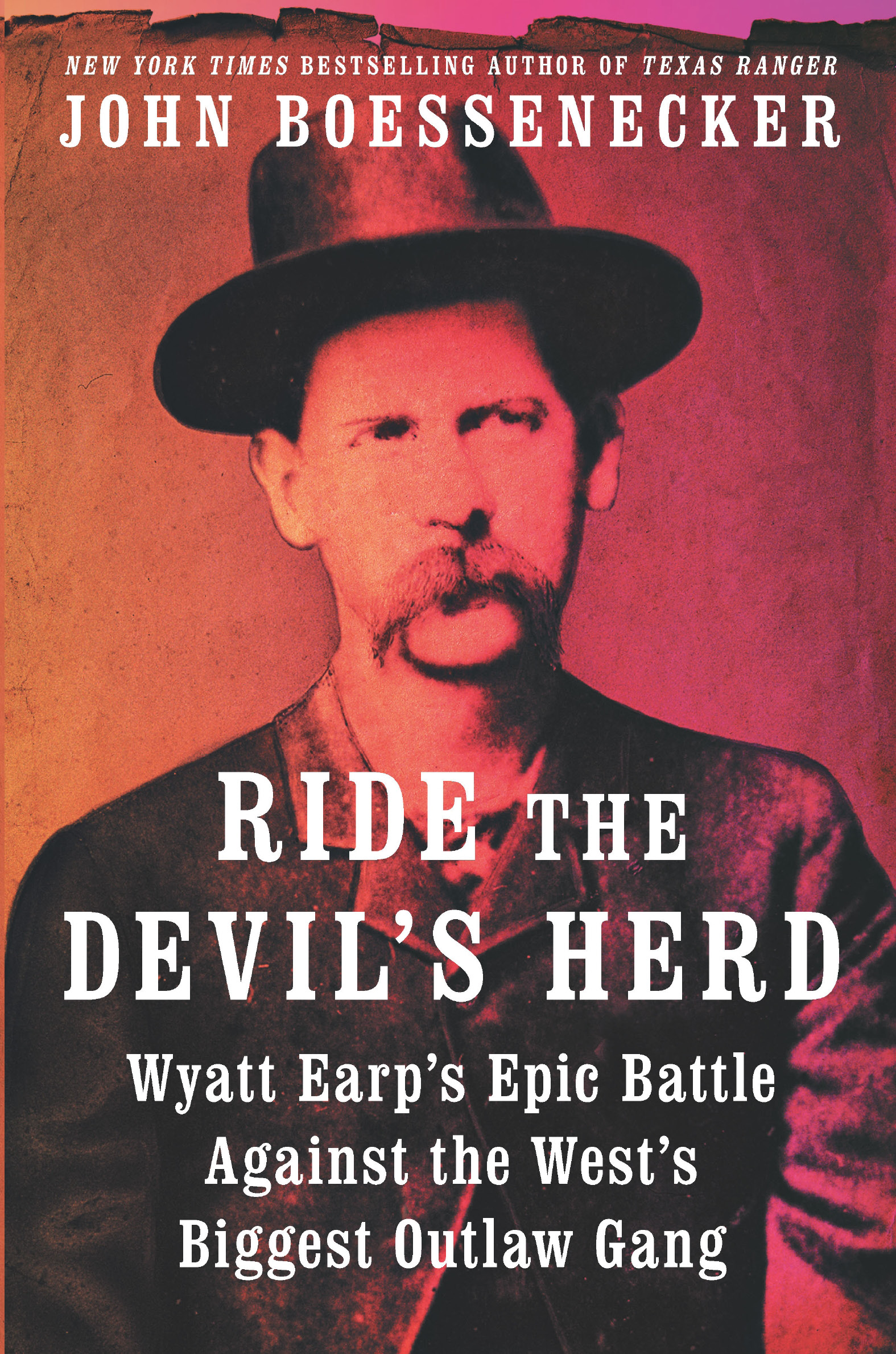
Wyatt Earp is regarded as the most famous lawman of the Old West, best known for his role in the Gunfight at the O.K. Corral in Tombstone, Arizona. But the story of his two-year war with a band of outlaws known as the Cowboys has never been told in full.
The Cowboys were the largest outlaw gang in the history of the American West. After battles with the law in Texas and New Mexico, they shifted their operations to Arizona. There, led by Curly Bill Brocius, they ruled the border, robbing, rustling, smuggling and killing with impunity until they made the fatal mistake of tangling with the Earp brothers.
Drawing on groundbreaking research into territorial and federal government records, John Boesseneckers Ride the Devils Herd reveals this long-forgotten chapter of Wild West history.
Praise for Texas Ranger
In terms of sheer action and violence, from close-quarters gunfights to Mexican-border ambushes to face-offs with lynch mobs, Im hard-pressed to think of [a biography of an American lawman and detective] that rivals John Boesseneckers excellent Texas Ranger... A notable achievement.
Wall Street Journal
Fair-minded and thorough... Boessenecker tells the gruesome story with power and force.
New York Times Book Review
The authors painstaking researchbrings forth an astounding story.... A superb account.
The Washington Times
A fascinating look into the epic life of one of the greatest American lawmen of the 20th century.
San Antonio Express-News
Boessenecker goes through Hamers career chronologically, methodically and in great detail, exploring both good and bad.
Austin American-Statesman
Colorful and comprehensive.
True West Magazine
Finally, a complete, thoroughly researched and true account of Frank Hamer, whose experiences proved that the Wild West didnt end in 1900. All of our favorite lawmen pale in comparison to Hamers service.... Frank Hamer was the real deal and arguably the greatest lawman of the West.
Roundup Magazine
Through the extraordinary experiences of this straight-shooting, honor-bound lawman, Boessenecker sets forth a critically needed look at the history of Texas lynchings and race riots while presenting evidence for the murderous nature of Bonnie and Clyde that foreordained their violent deaths.
Library Journal
A biography of Texas Ranger Frank Hamer, from his youth in the Hill Country to his appointment to the Rangers in 1906. Hes most famous for killing Clyde Barrow and Bonnie Parker in 1934, but theres much more to the cowboy lawman.
Fort Worth Star-Telegram
Frank Hamers is perhaps the last great story of the American West to be told.... Well, Hollywood? Now you have the book, so go make the movie.
Dallas Morning News
Also by John Boessenecker
Badge and Buckshot: Lawlessness in Old California
The Grey Fox: The True Story of Bill Miner, Last of the Old-Time Bandits (with Mark Dugan)
Lawman: The Life and Times of Harry Morse, 18351912
Gold Dust and Gunsmoke
Against the Vigilantes: The Recollections of Dutch Charley Duane
Bandido: The Life and Times of Tiburcio Vasquez
When Law Was in the Holster: The Frontier Life of Bob Paul
Texas Ranger: The Epic Life of Frank Hamer, the Man Who Killed Bonnie and Clyde
Shotguns and Stagecoaches: The Brave Men Who Rode for Wells Fargo in the Wild West
RIDE THE DEVILS HERD
Wyatt Earps Epic Battle Against the Wests Biggest Outlaw Gang
John Boessenecker

About the Author
JOHNBOESSENECKER is the author of ten books, including the New York Times bestseller Texas Ranger: The Epic Life of Frank Hamer, the Man Who Killed Bonnie and Clyde . He has received the Spur award from Western Writers of America, the Best Book award from Westerners International, and in 2011, 2013 and 2019 True West named him Best Nonfiction Writer. He has appeared frequently as a historical commentator on PBS, History, A&E and other media. He is a trial lawyer in San Francisco, California.
To my friend Paul Cool (19502016),
author, historian and gentleman.
Table of Contents
1
Devils from Hell: The Cowboys
P resident Chester Arthur shifted his 240-pound bulk in the leather chair, one hand gripping a fifty-ring cigar and the other a nib pen that he dipped rhythmically into an inkwell. A blustery December wind rattled the windows of his White House office as he alternately scribbled and puffed furiously. President James Garfield had died from an assassins bullet just ten weeks earlier, and now it was Arthurs duty to prepare his first State of the Union Address, then called the Presidents Annual Message to Congress. His report was a long one, beginning with the tragedy of Garfields death, followed by a review of foreign relations, Indian affairs, and the settlement of the West. He appealed for civil service reforms, more soldiers on the frontier, funding for the education of former slaves, repeal of internal revenue taxes, and the suppression of polygamy. Yet there was another pressing matter that no American president had ever confronted before: the bloody raids of a huge gang of outlaws on the Southwestern frontier.
As Arthur scratched pen across paper, he decried the disturbance of the public tranquillity during the past year in the Territory of Arizona. A band of armed desperadoes known as Cowboys, probably numbering from fifty to one hundred men, have been engaged for months in committing acts of lawlessness and brutality which the local authorities have been unable to repress. The depredations of these Cowboys have also extended into Mexico, which the marauders reach from the Arizona frontier. With every disposition to meet the exigencies of the case, I am embarrassed by lack of authority to deal with them effectually. The president called for Congress to pass legislation that would allow the U.S. Army to deal with the Cowboy threat.
To most Americans in 1881, cowboys were colorful, hardworking, and often rowdy stock tenders who drove cattle from Texas to the railheads in Kansas. But in Arizona and New Mexico, the bloody raids of a band of marauders known as Cowboys or Cow-boys had grabbed newspaper headlines, created a series of diplomatic incidents with Mexico, and finally caught the attention of the President of the United States. The name cowboy had become synonymous with desperado, bandit, and cutthroat. President Arthur surely had no idea who they were, where they came from, who they robbed, or who they killed. To the president, to Congress, and to the American public they were a nameless, faceless band that appeared wraithlike from the high desert, plundering and murdering and vanishing as quickly as they came. And contrary to President Arthurs statement, the Cowboys had not been engaged for months in committing acts of lawlessness and brutality. They had been robbing and killing for years.
The Cowboys genesis lay in the savvy and the six-shooters of John Kinney, one of the most notorious outlaws of the American Southwest. He was a New Englander, born to Irish parents in Hampshire County, Massachusetts, on May 4, 1847. When his father died, Kinneys mother moved with her seven children to Chicago. There John Kinney enlisted in the army in 1868 and entered training as a cavalryman. The recruit, almost twenty-one, was short and stockyfive foot five, 160 poundswith a round, deceptively cherubic face. Assigned to the Third U.S. Cavalry, he served on various frontier posts, including Fort Selden in southern New Mexico. Kinney acquired deep knowledge of the isolated country and its Spanish-speaking people. Keenly intelligent and a natural leader, Kinney was promoted to sergeant. He mastered rifle, revolver, horses, and the Spanish language, and later claimed to have taken part in campaigns against the Apaches and Sioux. In 1871, at Fort Bowie, Arizona, he married fifteen-year-old Juana Provencio, whose family lived in Mesilla, New Mexico. Kinney was mustered out at Fort McPherson, Nebraska, in April 1873, and soon returned to New Mexico Territory.
Next page

